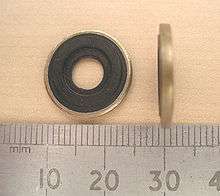Bodok seal
The Bodok seal is a specialised washer that ensures a gas-tight seal between the cylinder yoke or regulator of an anaesthetic machine or any medical device requiring a gas supply, and a gas cylinder. It was introduced along with the pin index safety system during the 1950s.
Attachment and detachment of a gas cylinder leads to constant wear and tear, due in part to mechanical distress and to gaseous compression and expansion. (Adiabatic effects in rapidly expanding compressed gases can generate very low temperatures,as is the case with a cryoprobe). Such fluctuation in temperatures necessitates a durable and rugged material: neoprene. Prior to the introduction of the Bodok seal, the traditional fibre washer would frequently splay and cause leakage or adhere to the regulator, thus requiring the use of pliers and considerable force to remove it.
The Bodok seal consists of a neoprene washer with a peripheral metal reinforcing ring which prevents splaying of the washer. The seal is incombustible and resistant to the high pressures imposed upon it by cylinder gases (a full cylinder has a pressure of approx 2000 psi / 140 bar).
Care must be taken when replacing gas cylinders that the bodok seal does not stick to the cylinder face when the cylinder is replaced and is thus 'lost' when the new cylinder is fitted and is therefore impossible to achieve a gas tight seal.
Bodok seals are also used in emergency oxygen kits used in scuba diving, but diving regulators used underwater generally use a conventional o-ring seal.

External links
- Bodok seal note (See "Historical Forum" following "Nerve Plexus" article)